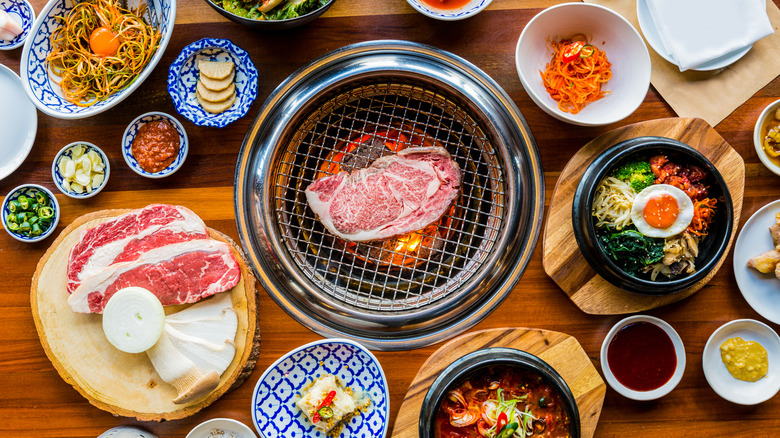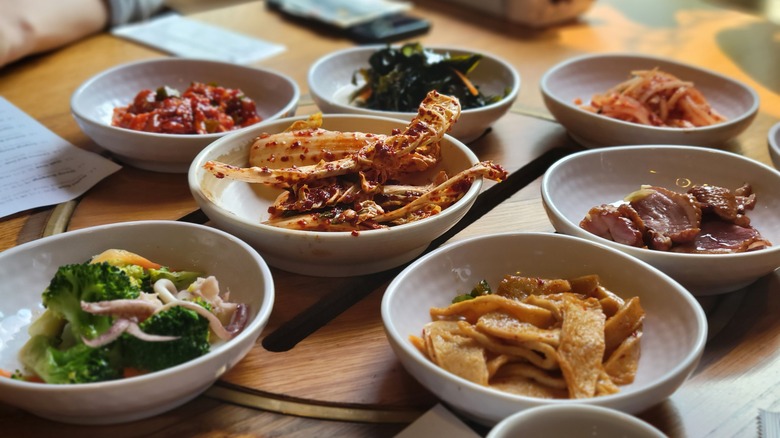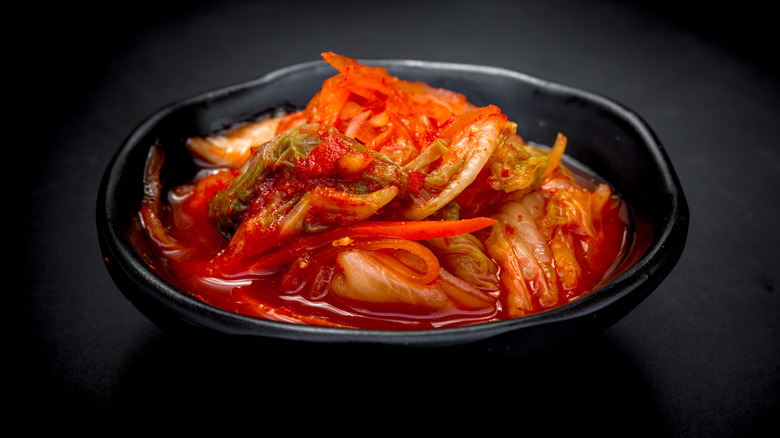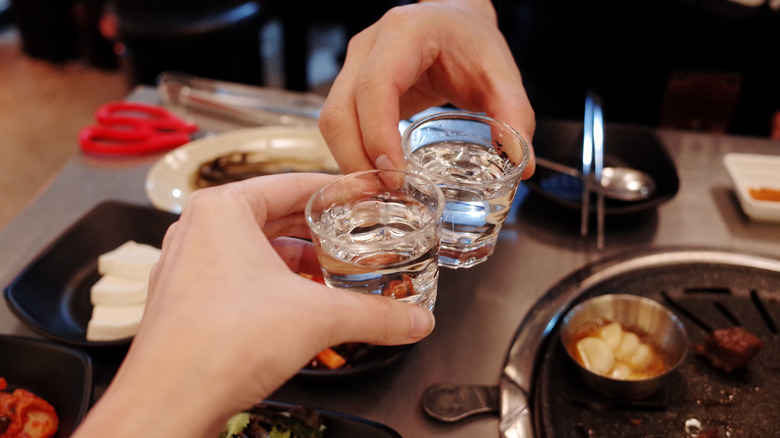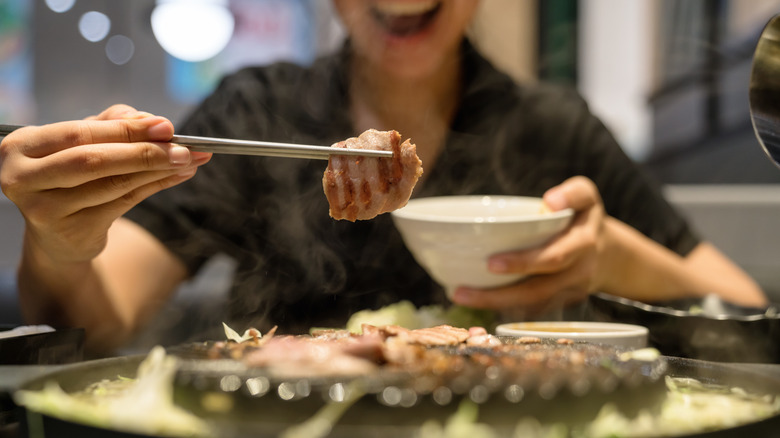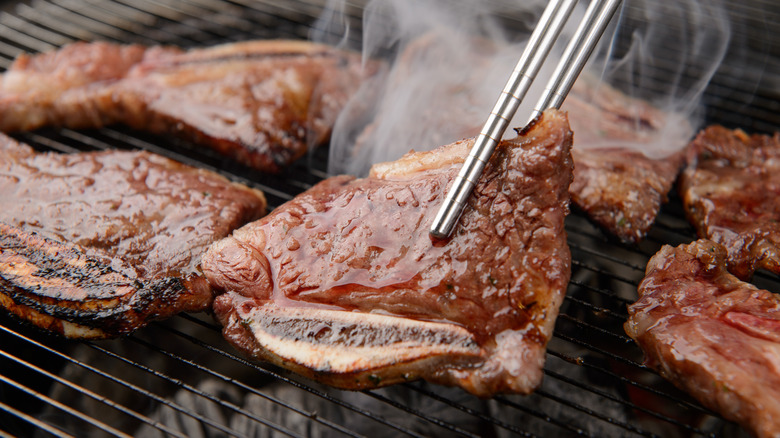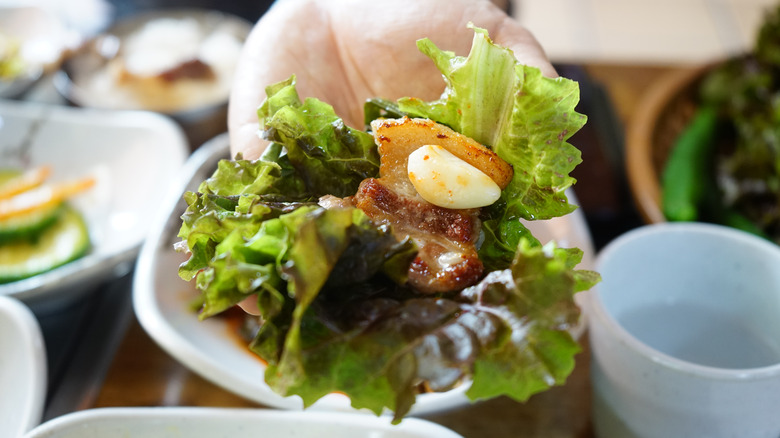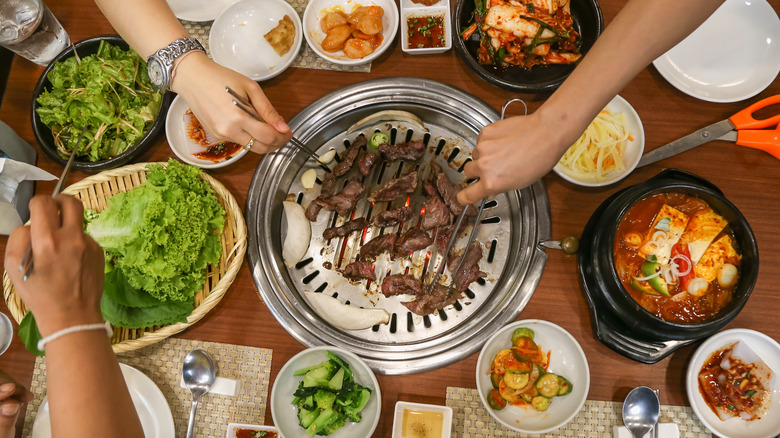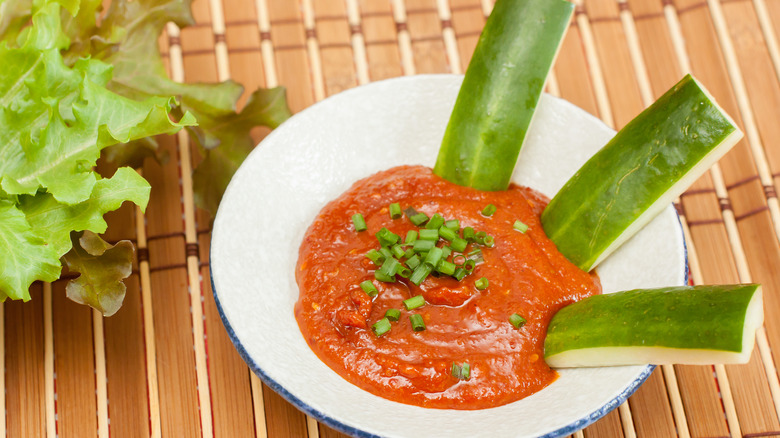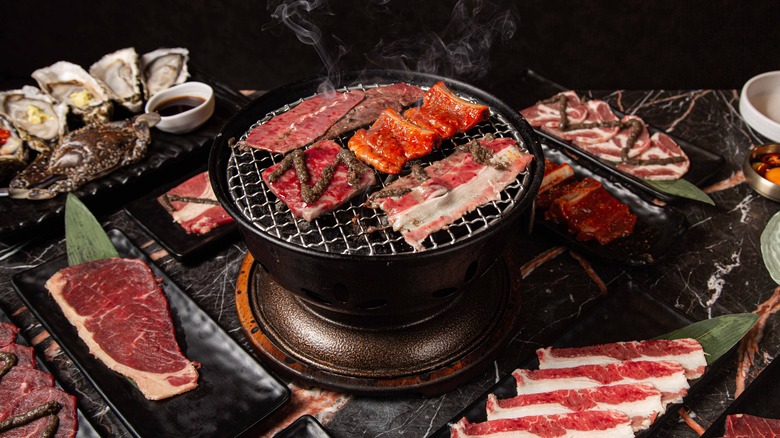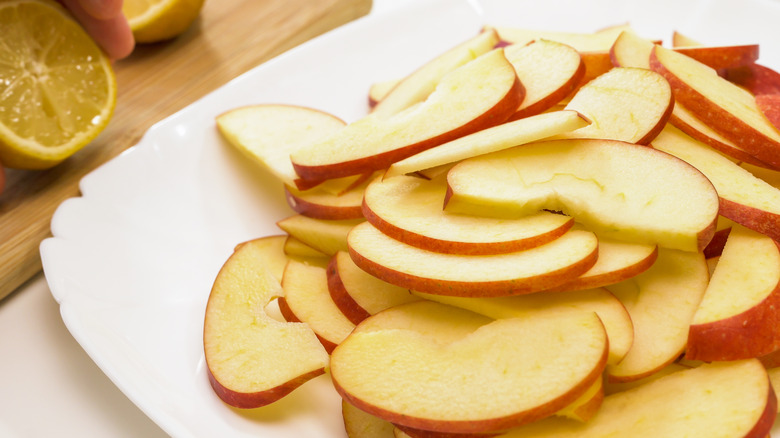Mistakes Everyone Makes When Eating Korean BBQ
Historically, Korean barbecue is believed to have originated in Central Asia among the Maek nomadic group who cooked seasoned meat over an open fire (via Korean BBQ). Since then, the preparation has taken the world by storm, and there are plenty of good reasons why. Consisting of a lineup of side dishes called banchan and flame-grilled strips of meat cooked right at the table, Korean barbecue is more of an adventure than a meal.
In traditional Korean barbecue restaurants, the delicious morsels of meat are prepared on grill pits built into the middle of the table and filled with red-hot coals (via "Cooking Through History"). Meanwhile, in more modern Korean barbecue joints, gas or electric grills are often used as an alternative. Whatever the setup, you can rest assured that your feast is bound to be mouth-watering, varied, and colorful.
Steeped in tradition, this communal dining experience presents a window into Korea's food and culinary etiquette. Unfortunately, for many newbies, the intricacies of restaurants serving this specialty can be daunting. To give you a head start, here are some of the most common mistakes people make when eating Korean barbecue.
Filling up on side dishes or banchan
Banchan (Korean side dishes) are typically served early on in the proceedings before the meat is grilled. However, this doesn't mean that filling up on these small plates is a good idea. Digital creator James Park explains to Thrillist that banchan aren't appetizers. Having grown up in Korea, he is eager to share his culinary know-how with others, saying, "they're more meant to complement each bite and to make them exciting by creating different kinds of flavor combinations." Banchan are also meant to cleanse the palate by offsetting the flavors of various meats (via Serious Eats).
While the complimentary side dishes are plentiful, they aren't usually listed on the menu. This means that you can expect a whole range of exciting tidbits you may not be familiar with. Perhaps the most well known banchan is probably kimchi, a combination of fermented vegetables, ginger, garlic, and fish sauce. Other banchan can include kongnamul (seasoned soybean sprouts), danmuji (pickled radish), cheongpomuk (mung bean jelly), gamja saelleodeu (potato salad), and eomuk bokkeum (fried fish cakes), per Thrillist. Park points out that while diners can feel free to order banchan refills, leaving leftover nibbles is considered a big no-no.
Not grilling the kimchi
Side dishes are an indispensable part of the Korean barbecue experience. And kimchi is by far one of the cuisine's most beloved small plates. In fact, according to a poll released by the Korean Ministry of Agriculture for Food and Rural Affairs, kimchi is also the most popular Korean dish internationally (via The Korea Times).
While the fermented side dish is delicious when eaten raw, grilling kimchi can give it a different layer of flavor. This is because placing the sour vegetables on the grill introduces tantalizing smoky caramelized undertones (via Online Grill). James Park tells Thrillist that pork or beef fat really sets this side dish on another level. And all it takes is a minute or two. Crazy Korean Cooking recommends draining the kimchi before placing it on the grill for successful results. In addition, it's best to grill the cabbage leaves individually rather than placing a large batch on the grill all at once.
Being careless with soju
All the flavors of Korean barbecue are bound to leave you thirsty which makes soju an indispensable addition to the table. Made from rice, barley, or wheat, the crisp drink comes with a pleasantly sweet aftertaste (via TripZilla). At around 20% alcohol by volume, the clear beverage is traditionally drunk from shot glasses (via Matador Network). While soju isn't as strong as hard liquor, it definitely has the edge on beer and should be consumed with some caution.
Drinking soju at a Korean barbecue feast comes with its own set of rules. Since it isn't meant to be enjoyed alone, pouring your own drink is also a huge no-no. Instead, Matador Network explains that the eldest person at the table typically kicks off the drinking session by pouring the first shots for their companions. The bottle and the glass should be held with both hands while the liquor is being poured. And while soju can be bombed back, this only applies to the first shot since the liquor is meant to be sipped and savored throughout the meal.
If soju isn't your cup of tea, you can always wash down your meal with somaek, a refreshing blend of soju and beer. South China Morning Post reports that the range of ratios varies, but three parts soju to seven parts beer is common in Korea.
Incorrectly using the utensils
Even if you are a regular at your local Japanese or Chinese restaurant, cutlery at a Korean barbecue can leave you stumped. Korean place settings feature a spoon and metal chopsticks that are flat rather than rounded. The spoon is generally used for rice and soups and the chopsticks for grilling and eating meat. Since rice is eaten with a spoon rather than chopsticks, raising your bowl or plate from the table is viewed as ill-mannered in Korea (via Serious Eats).
Chopstick placement is also an important part of Korean dining etiquette. When they are not being used, set them on top or beside your bowl on a small chopstick rest. Avoid poking your chopsticks into your bowl of rice; in Korean tradition, this is associated with funeral ceremonies (via 90 Day Korean).
In case you feel that your chopstick skills aren't up to scratch, don't be afraid to ask for a fork and spoon. As one Quora member points out, "[...] even if you are in a Korean restaurant in South Korea. They know and have known for decades that Westerners do not know how to use [chopsticks]. They also much prefer you enjoy your food with the utensils you are familiar with versus struggling and dropping your food on yourself, the table, or the floor."
Assuming that you cook your own meat
After you get settled and place your order at a Korean barbecue restaurant, the server will fire up the grill. This typically involves placing coal briquettes in the barbecue pit and covering it with a grate. The meat is typically brought to the table as the grill is heating up. Depending on the restaurant, the server may take responsibility for the grilling (via Bon Appétit).
As soon as the coal is hot enough, the server (or you) will start the cooking process by placing slices of meat on the grill. Once in a while, the servers stop by to flip the meat. They will also leave a pair of tongs next to the grill, so don't be afraid to take over if they are busy. If a piece of meat looks cooked and your server is nowhere to be seen, transfer it to your plate to enjoy.
Overloading the lettuce wrap
Most Korean barbecue restaurants provide a basket of lettuce or perilla leaves to contrast the hearty meat slices. The leafy vegetables are used to make ssam or small packages of meat, rice, and condiments. The lettuce wraps should be compact enough to be devoured in one bite, Serious Eats recommends. After all, overloading a lettuce leaf can get messy. Once you've wrapped up the meat, feel free to eat the savory nibbles with your hands.
Unlike the meat which is usually grilled by a server, making ssam is the diner's responsibility. To build the delicious bundles, start by placing a lettuce or perilla leaf in the palm of your hand. Then add some slices of meat — you can dip them in sesame oil if desired — and some ssamjang, a thick and spicy Korean paste (via My Korean Kitchen). Optional accompaniments include chopped onion and green peppers, and raw or cooked garlic (via Miss Korea BBQ).
Not sharing your food
Korean barbecue feasts are meant to be a communal experience and both banchan and grilled meat should be shared among guests. As such, the Korean ritual provides a chance not only to refuel but also to reunite with friends and family. Lauren Bull aptly refers to the experience of mixing and matching Korean barbecue dishes as "an orchestra instead of a series of soloists" (via Crazy Korean Cooking). While sharing is an important part of the dining experience, avoid cross-contamination by only touching the food you will eat with your chopsticks.
A practice that highlights the communal nature of Korean barbecue is to share the best morsels with your loved ones. This is done by literally placing the most coveted bites on their plates. Another way of showing you care is by building a lettuce wrap and offering it to your co-diner, James Park tells Thrillist. It's also polite to pace yourself to avoid completing your meal before the oldest person in the group has finished (via 90 Day Korean).
If you absolutely have to eat at a Korean restaurant alone, self-proclaimed South Korean culture enthusiast Jason Park from the Korean Guide advises ordering at least two types of meat. However, he also points out that consuming such a vast amount of food solo could be tricky due to the large portion sizes.
Skipping out on the dipping sauces
Used in moderation, sauces can provide an entirely new dimension to Korean barbecue. Perhaps the most popular addition to grilled meat is ssamjang. The thick dipping sauce combines doenjang (fermented soybean paste), gochujang (fermented chili paste), as well as green onions, garlic, sesame oil, and sugar or honey. Ssamjang features a complex flavor that is simultaneously tart, salty, savory, and sweet. Try dipping slices of grilled meat in the sauce or use it to elevate the flavor of your lettuce wraps (via Takeout).
Another sauce that is likely to land on your table at a Korean barbecue restaurant is sesame oil with salt and pepper. Whereas ssamjang is intensely flavorful, this condiment is subtle and pairs well with vegetables and meat that isn't marinated. The simple blend can be too mild to stand up to the flavors of marinated meat (via Carving a Journey).
Not being adventurous when ordering meat
There's little doubt that the star of all Korean barbecues is meat. Esther Choi, chef-owner of mokbar in New York City, tells Greatist that anyone looking for traditional cuts should opt for flank steak, galbi (short ribs), and bulgogi (sliced rib-eye). And if red meat or pork isn't your jam, there's always chicken. The cuts of meat generally come in either marinated or unmarinated versions (via Matador Network).
While these meat cuts are certainly great choices, Korean barbecue has a lot more to offer for those willing to step outside their comfort zone. In South Korea, for example, many barbecue restaurants serve offal. Although some cuts of meat aren't a big part of the traditional dining culture in the U.S., it's worth tasting them if they appear on the menu. James Park recommends thinly sliced beef tongue, which he says "just melts in your mouth" (via Thrillist). Some other grilled specialties include gopchang (intestines), so-makchang (the last stomach component of cattle), and dwaeji ggupdaegi (pigskin), per My Seoul Box.
Trying to order dessert
While this may come as a surprise, not every country in the world is into dessert. The final course, as we know it in the West, simply isn't an inherent part of Korean culture. Instead, sweet tidbits are akin to snacks and can be eaten at any time of the day — not just at the end of a meal (via Crazy Korean Cooking).
While some Korean restaurants in the U.S. cater to Americans and serve dessert, it's not a given that you will find a selection on the menu of your local Korean barbecue joint. Although you can certainly ask for something sweet to finish off your meal, don't be disappointed if a dessert isn't available. According to Korea Times, Koreans traditionally enjoy more nutritious alternatives including pears, persimmons, and apples. And up to this day, some Korean barbecue restaurants end the meal with a serving of peeled fruit.
